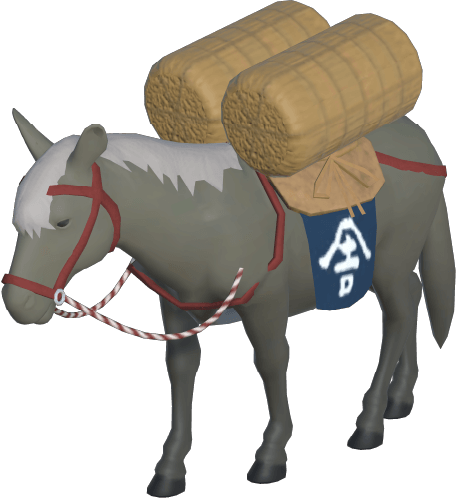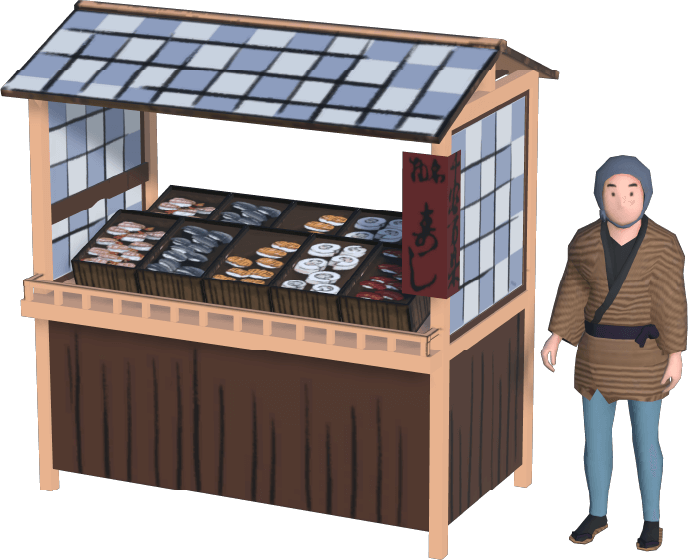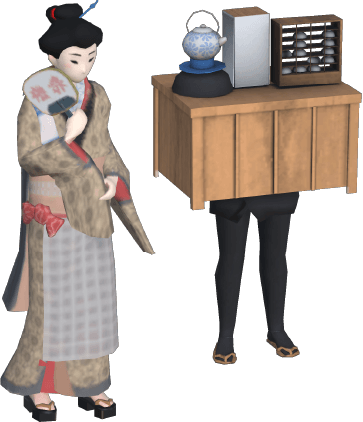Hyper Edohaku:
Nihonbashi Edition
2024.04.22 Release
Hyper Edohaku:
The Edo-Tokyo Museum App




How much?
Money makes the world go round
A new version of Hyper Edohaku, the popular interactive phone app from the Edo-Tokyo Museum, has been released, focusing on the money situation in the Edo period.
In Edo, people and goods gathered from across Japan, fostering the development of diverse businesses. Players become one of the merchants and experience the money-related culture of Edo through their lives.
The main character is the third-generation young master of a lantern shop in Nihonbashi. Disowned by his parents and penniless, he searches for a place to live, finds a job, learns about money and business, and opens up a new path in life.




Live in a loincloth
The main character gets so excited about watching kabuki plays that he ends up spending money from his family's store.
His father disowned him and finally kicked him out of the house.

Discover 100 Items from the Museum Collection
The main character lives in Nihonbashi during the Edo period, which flourished as a commercial center.
The bustling thoroughfare of Nihonbashi, teeming with various types of businesses, has been recreated in a 3D space.
Hidden in the landscape are 100 items, especially selected from the 350,000 in the museum collection.



















The vibrant Nihonbashi district has been recreated
in a 3D space.
The story takes place in a 3D space created based on materials from the Edo period in the Edo-Tokyo Museum's collection and a reconstructed model of the Nihonbashi Bridge.

Hyper Edohaku:Nihonbashi

How to use money in Edo
How did the common people of Edo perceive money compared to modern-day standard?
The app vividly portrays various scenarios depicting the usage of money in Edo, from everyday expenses such as food, clothing, and housing to disparities in wages, and even ceremonial occasions like funerals and weddings.

One ryō was about 100,000 yen in modern terms.

In the Edo period, there were basically three types of coins used: gold, silver, and copper coins. One ryō was approximately 4,000 mon, or about 100,000 yen in modern terms.

400 yen for egg sushi

In the Edo period, nigirizushi became a boom. Fish such as sea eel, shrimp, and white fish were the most common ingredients. Prices were 8 mon (about 200 yen) per piece and 16 mon (about 400 yen) for the egg.

3,000 yen for 3kg of white rice

Edo people preferred white rice. As a result, Beriberi caused by a vitamin B1 deficiency was common in Edo and was called "Edo wazurai" (Edo illness ).

Adult 250 yen for bathing

As a rule, the bathhouse was open from 6:00 a.m. to 6:00 p.m. The bathtub was small and dark, so people entered the bathtub saying, "I am a countryman, a cold one".

3 million yen for wedding equipment

Life's milestones cost money. The middle class was expected to spend more than 2 ryō (about 200,000 yen) for the betrothal gifts and about 30 ryō (about 3,000,000 yen) for the wedding trousseau. Other expenses included dowry, wedding feasts, and gratuities.

Various businesses in Edo
In Edo, where people gathered from all over Japan, there were many different types of businesses. The main street from Kanda to Nihonbashi is lined with odana (large merchant, lit., “big stores”), and while there are businesses that support people's daily lives, such as bathhouses, secondhand clothing stores, and fishmongers, there are also many businesses that flourished, such as moneylenders and money changers.
The Nihonbashi area,
where large sums of money flow every day
In the Nihonbashi area during the Edo period, there were three places where 1,000 ryo (about 100 million yen today) of money moved in one day.

Kabuki theater
Kabuki actors with contracts exceeding 1,000 ryo per year, known as "senryo yakusha," appeared in this period.

Fish market
The Nihonbashi fish market began as a place to sell leftover fish delivered to the shogunate.

Echigo-ya
A kimono merchant who overturned the conventional wisdom of the time with his revolutionary sales methods
The main character earns his daily bread in a variety of occupations.
The costumes also change according to the occupation.






Let's visit Nihonbashi in the Edo period and collect 100 items from the Edo-Tokyo Museum's collection!

Find
Tap and drag characters around the screen to find the items you seek. Rotate your perspective with the left and right buttons. The pin button allows you a birds-eye view of your and the items’ locations you are looking for.

Discover
Tap on the people or items that are outlined in white to collect them. The items you seek are contoured as clues at the bottom of your screen. The direction of the confetti will also help you.

Collect
Items you have discovered will be stored in your collection book. Find and collect all 100 items to complete your collection.




